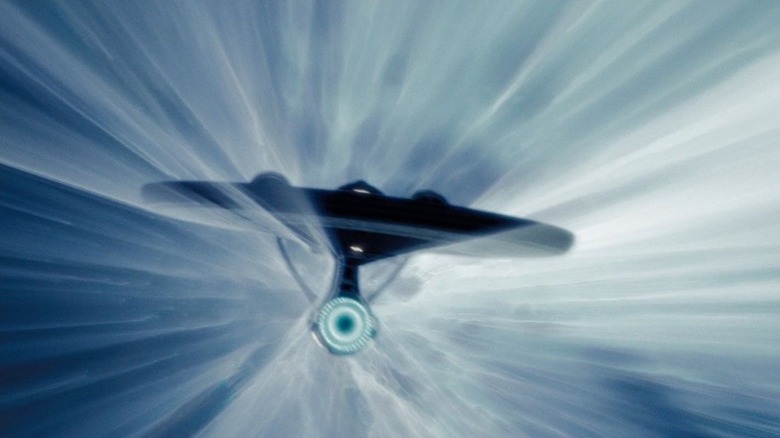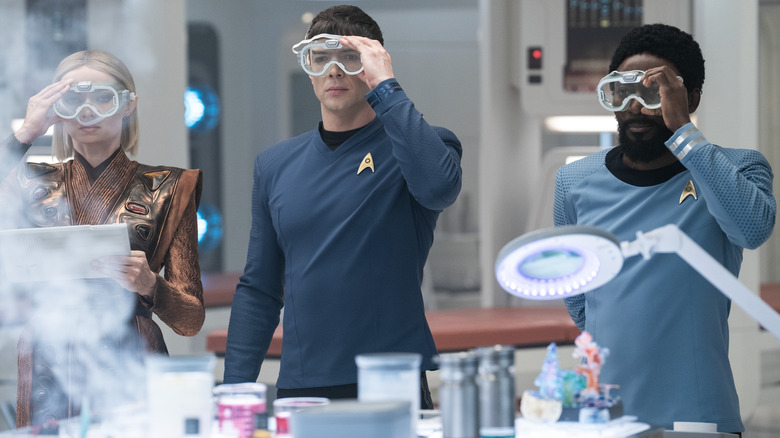All through its practically 60 years of films and reveals, “Star Trek” has featured high-tech communication gadgets that vaguely resemble old-school flip telephones, magical replicators that may conjure just about any recognized object at will, and a galaxy filled with aliens that occur to look similar to people (though there is a strong canonical motive for that now). However for each goofy-looking visor or turbo raise that requires passengers to seize onto a deal with, there are numerous extra devices and theories which have a foundation in precise science. Now, one of the far-fetched ones could possibly be nearer than ever to turning into a actuality.
Even probably the most informal of “Trek” followers have heard concerning the warp drive machine that enables the assorted starships of the Federation to skip by way of house within the (relative) blink of an eye fixed. There is a motive why faster-than-light journey has remained a fixture in sci-fi for properly over a century, in spite of everything. House may be very, very huge, and humanity has at all times dreamed of venturing out very, very far. So far, nevertheless, this expertise hasn’t simply been thought-about out of our attain — it is downright unattainable, as it could defy all of the legal guidelines of physics as we all know it. The largest one of all of them? Thou shalt not journey quicker than gentle, the universally-accepted velocity restrict of the universe.
Because it seems, perhaps it is time we went again to the drafting board. Based on a current article by Nationwide Geographic, there could also be a strategy to flip this specific piece of fiction into reality … and “Star Trek” may find yourself being a significant motive why. Astrophysicist and warp drive researcher Alexey Bobrick is quoted as saying, “It is superb how science fiction writers think about issues, and we then determine they’ll work. It is actually fairly lovely.”
How does Star Trek’s warp drive work, anyway?
Imagine it or not, it seems that Gene Roddenberry (famously a stickler for guidelines) and his “Star Trek: The Authentic Collection” writers had been forward of their time. Though visually just like how, say, the Millennium Falcon travels by way of hyperspace in “Star Wars,” the usage of the warp drive in “Star Trek” comes a lot nearer to aligning with real-world physics than we ever may’ve anticipated.
Based on the made-up guidelines of this franchise, the warp drive primarily works by folding space-time round a shifting starship right into a bubble, which is then sped as much as velocities that far exceed the velocity of sunshine. (That is positively an oversimplified model, because it entails far an excessive amount of math and decimal factors to correctly clarify right here. I will go away that to the fan wikis, thanks very a lot.) In comparison with different sci-fi properties that depend on wormholes or slipstream strategies or what have you ever, “Trek” manages to keep away from the pesky drawback {that a} sure genius named Albert Einstein got here up with — particularly, the speculation of relativity that states no objects within the recognized universe can bodily journey quicker than gentle. Whereas this would appear to incorporate objects corresponding to starships, “Trek” posits that it’s not the USS Enterprise that is being warped to unattainable speeds, however precise space-time.
This technicality is the important thing, apparently. And we have seen this in dwell motion earlier than, as one gloriously nerdy shot in 2016’s “Star Trek Past” depicted (and pulled from precise physics, as defined to Trek Core right here). Nationwide Geographic spoke with “Trek” science advisor and astrophysicist Erin MacDonald, who defined:
“In the event you wrap your ship within the cloth of spacetime after which that cloth goes quicker than gentle, carrying you with it, that is really not breaking any legal guidelines of physics.”
Science nonetheless has a protracted strategy to go to catch as much as Star Trek … however it’s getting nearer
Okay, simply to be clear, we’re not fairly on the level the place we will all join Starfleet Academy and enterprise out to the celebrities with large eyes and clear hearts … however we’re getting a little bit nearer! The Nationwide Geographic report goes on to clarify how the greatest impediment is not the idea of warp drive itself, however the immense quantities of power required to make it work. One analysis paper printed again in 1994 theorized squeezing space-time forward of a spaceship and increasing space-time behind, the primary accepted scientific mannequin exhibiting the warp concept in motion. The one downside? To maneuver even the tiniest of objects, this methodology required power approximate to the mass of our solar.
Fortunately, science has superior by leaps and bounds since 1994. Alexey Bobrick, the astrophysicist quoted earlier, teamed up with Gianni Martire to discover a warp bubble resolution much more possible than earlier ones. Whereas theirs at present requires a lot much less power (someplace on the extent of some objects the dimensions of Jupiter), it nonetheless hasn’t cracked the flexibility to journey quicker than gentle. However even this small quantity of progress represents the most important step but in the direction of a practical warp drive. It is now a matter of merely making it so … or, in non-Picard phrases, determining the right way to improve the velocity whereas lowering the quantity of power required.
The report cautions that we stay “a number of lifetimes” away from ever implementing any of this on a working spaceship – barely much less optimistic than the 2063 date of “First Contact” with the Vulcans, following a profitable take a look at of a warp drive in franchise canon — however we’re nonetheless taking this as a win.



